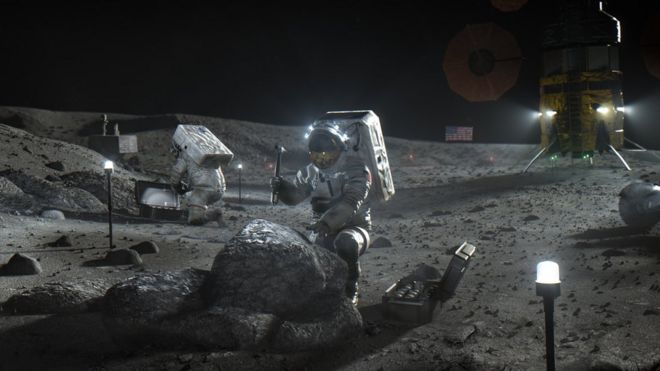The US space agency (Nasa) has formally outlined its $28bn (£22bn) plan to return to the Moon by 2024.
As part of a programme called Artemis, Nasa will send a man and a woman to the lunar surface in the first landing with humans since 1972.
But the agency’s timeline is contingent on Congress releasing $3.2bn for the agency to build a landing system.
Astronauts will travel in an Apollo-like capsule called Orion that will launch on a powerful rocket called SLS.
Speaking on Monday afternoon (US time), Nasa administrator Jim Bridenstine said: “The $28bn represents the costs associated for the next four years in the Artemis programme to land on the Moon. SLS funding, Orion funding, the human landing system and of course the spacesuits – all of those things that are part of the Artemis programme are included.”
But he explained: “The budget request that we have before the House and the Senate right now includes $3.2bn for 2021 for the human landing system. It is critically important that we get that $3.2bn.”
The US House of Representatives has already passed a Bill allocating $600m towards the lunar lander.
But Nasa will need more funds to develop the vehicle in full.
Mr Bridenstine added: “I want to be clear, we are exceptionally grateful to the House of Representatives that, in a bipartisan way, they have determined that funding a human landing system is important – that’s what that $600m represents. It is also true that we are asking for the full $3.2bn.”
The new document outlines Phase 1 of the plan, which includes an uncrewed test flight around the Moon – called Artemis-1 – in the autumn of 2021.
Nasa’s human spaceflight chief Kathy Lueders said that Artemis-1 would last for about a month to test out all the critical systems.
She said that demonstration flight would reduce the risk for Artemis-2, which will repeat the trip around the Moon with astronauts.
A new test has been added to this mission – a proximity operations demonstration. Shortly after Orion separates from the upper-stage of the SLS rocket – known as the interim cryogenic propulsion stage – astronauts will manually pilot the spacecraft as they approach and back away from the stage.
This will assess Orion’s handling qualities, along with the performance of the spacecraft’s hardware and software.
Artemis-3 will become the first mission to send astronauts to the lunar surface since Apollo 17 some 48 years ago.




